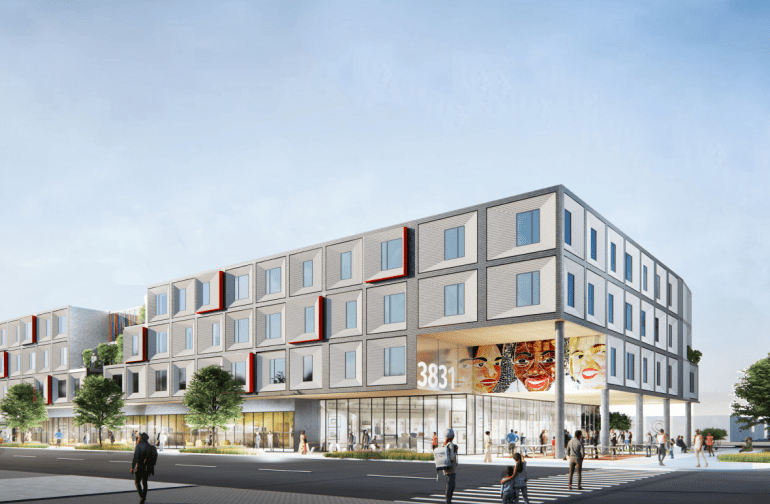As low-income households face the dual burden of weather extremes and high energy costs, energy efficiency is an increasingly important strategy for both climate mitigation and lower utility bills.
Passive House standards — which create a building envelope so tight that central heating and cooling systems may not be needed at all — promise to dramatically slash energy costs, and are starting to appear in “stretch codes” for buildings, including in Massachusetts, Illinois, Washington and New York.
And while some builders are balking at the initial up-front cost, other developers are embracing passive house metrics as a solution for affordable multifamily housing.
“We’re trying to make zero energy, high performing buildings that are healthy and low energy mainstream everywhere,” said Katrin Klingenberg, co-founder and executive director of Passive House Institute-U.S., or Phius.
Klingenberg says the additional work needed to meet an aggressive efficiency standard, is, in the long run, not that expensive. Constructing a building to passive standards is initially only about 3%-5% more expensive than building a conventional single family home, or 0%-3% more for multifamily construction, according to Phius.
“This is not rocket science… We’re just beefing up the envelope. We’re doing all the good building science, we’re doing all the healthy stuff. We’re downsizing the [heating and cooling] system, and now we need someone to optimize that process,” Klingenberg said.
Phius in practice and action
A Phius-certified building does not employ a conventional central heating and cooling system. Instead, it depends on an air-tight building envelope, highly efficient ventilation and strategically positioned, high-performance windows to exploit solar gain during both winter and summer and maximize indoor comfort.
The tight envelope for Phius buildings regulates indoor air temperature, which can be a literal lifesaver when power outages occur during extreme heat waves or cold snaps, said Doug Farr, founder and principal of architecture firm Farr Associates.
Farr pointed to the example of the Academy for Global Citizenship in Chicago, which was built to Phius standards.
“There was a really cold snap in January. Somehow the power went out [and the building] was without electricity for two or three days. And the internal temperature in the building dropped two degrees over three days.”
Farr said that example shows a clear benefit to high efficiency that justifies the cost.
“You talk about the ultimate resilience where you’re not going to die in a power outage either in the summer or the winter. You know, that’s pretty valuable.”
There is also a business case to be made for implementing Phius and other sustainability metrics into residential construction, such as lowered bills that can appeal to market-rate buyers and renters, and reduced long-term maintenance costs for building owners.
AJ Patton, founder and CEO of 548 Enterprise in Chicago, says in response to questions about how to convince developers to consider factors beyond the bottom line, simply, “they shouldn’t.”
Instead, he touts lower operating costs for energy-efficiency metrics rather than climate mitigation when he pitches his projects to his colleagues.
“I can’t sell people on climate change anymore,” he said. “If you don’t believe by now, the good Lord will catch you when He catch you.
“But if I can sell you on lowering your operating expenses, if I can sell you on the marketability, on the fact that your tenants will have 30%, 40% lower individual expenses, that’s a marketing angle from a developer owner, that’s what I push on my contemporaries,” Patton said. “And then that’s when they say, ‘if you’re telling the truth, and if your construction costs are not more significant than mine, then I’m sold.’”
Phius principles can require specialized materials and building practices, Klingenberg said. But practitioners are working toward finding ways to manage costs by sourcing domestically available materials rather than relying on imports.
“The more experienced an architect [or developer] gets, they understand that they can replace these specialized components with more generic materials and you can get the same effect,” Klingenberg said.
Patton is presently incorporating Phius principles as the lead developer for 3831 W Chicago Avenue, a mixed use development located on Chicago’s West Side. The project, billed as the largest passive house design project in the city to date, will cover an entire city block, incorporating approximately 60 mixed-income residential units and 9,000 sq ft of commercial and community space.
Another project, Sendero Verde, located in the East Harlem neighborhood of New York City, is the largest certified passive-house building in the United States with 709 units. Completed in April, Sendero Verde is designed to provide cool conditions in the summer and warmth during the winter — a vast improvement for the low-income and formerly unhoused individuals and families who live there.
Barriers and potential solutions
Even without large upfront building cost premiums and with the increased impact of economies of scale, improved technology and materials, many developers still feel constrained to cut costs, Farr said.
“There’s entire segments of the development spectrum in housing, even in multifamily housing in Chicago, where if you’re a developer of rental housing time and again … they feel like they have no choice but to keep things as the construction as cheap as possible because their competitors all do. And then, some architecture firms only work with those ‘powerless’ developers and they get code-compliant buildings.”
But subsidies, such as federal low income housing credits, IRS tax breaks and resources from the Department of Energy also provide a means for developers to square the circle, especially for projects aimed toward very low-income residents.
Nonetheless, making the numbers work often requires taking a long-term view of development, according to Brian Nowak, principal at Sweetgrass Design Studio in Minnesota. Nowak was the designer for Hillcrest Village, an affordable housing development in Northfield that does not utilize Phius building metrics, but does incorporate net-zero energy usage standards.
“It’s an investment over time, to build resilient, energy-efficient housing,” he told the Energy News Network in June 2023.
“That should be everyone’s goal. And if we don’t, for example, it affects our school system. It affects the employers at Northfield having people that are readily available to come in and fill the jobs that are needed.
“That’s a significant long-term benefit of a project like this. And that is not just your monthly rents on the building; it’s the cost of the utilities as well. When those utilities include your electricity and your heating and cooling that’s a really big deal.”
Developers like Patton are determined to incorporate sustainability metrics into affordable housing and commercial developments both because it’s good business and because it’s the right thing to do.
“I’m not going to solve every issue. I’m going to focus on clean air, clean water, and lowering people’s utility bills. That’s my focus. I’m not going to design the greatest architectural building. I’m not even interested in hiring those type of architects.
“I had a lived experience of having my heat cut off in the middle of winter. I don’t want that to ever happen to anybody I know ever again,” Patton said. “So if I can lower somebody’s cost of living, that’s my sole focus. And there’s been a boatload of buy-in from that, because those are historically [not] things [present] in the communities I invest in.”
No longer a niche, Passive House standards becoming a solution for highly efficient affordable housing is an article from Energy News Network, a nonprofit news service covering the clean energy transition. If you would like to support us please make a donation.
Leave a comment





